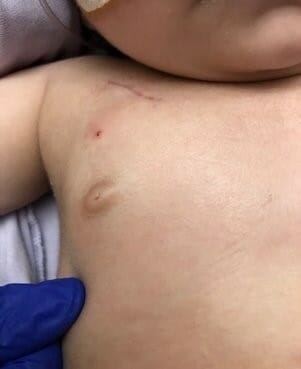In the complex and often strained systems of healthcare, groundbreaking treatments and cutting-edge technologies dominate the headlines. Yet, we sometimes neglect the subtle and most commonly used elements that quietly shape the experience of millions of patients.
Enter medical dressings. A simple dressing application holds the power to both heal and harm. However, beneath their seemingly straightforward design exists a realm of concerns. When the wrong dressing is used it can cause significant harm affecting everyone from the tiniest of babies in the NICU to vulnerable adults, clinicians, caregivers, and even hospital administration.
A Beneath-the-Surface Threat (The Threats We Don’t See)
Medical Dressings act as a barrier between open wounds, surgical incisions or IV sites, and the outside world.
They bind directly to patient skin, serving multiple roles:
- Securing devices
- Shielding patients from infections
- Safeguarding wounds and sites from environmental hazards
- Delivering treatments to accelerate the healing process.
Medical dressing sticks with patients through the ups and downs of treatment and recovery. However, a closer look reveals that the unpretentious dressings can create a host of unexpected complications, including but not limited to:
- Medical adhesive related skin injury (MARSI)
- Chemical skin burns
- Failure to protect from bloodstream infections.
- Disruption to treatment
- Patient pain and trauma
Dressing decisions that matter: Choose and use wisely
Everything from the dressing’s chemical makeup and adhesive substance to its design, how it’s applied, and how long it is worn can influence whether a dressing aids in healing or causes unnecessary harm.
Let’s consider, for example, both the design and duration a dressing is worn.
Not all dressings are made equal. While some have a dense presence of chlorohexidine, others incorporate it more evenly throughout the dressing. Certain dressings use harsh acrylic adhesives, whereas others employ gentle, soft silicone. These dressing design elements, paired with how long they are used, can dramatically impact patient experience.
The prolonged use of medical dressings can lead to a range of issues, from mild skin irritation to painful blisters. These harmless materials, meant to provide comfort and protection, can inadvertently disrupt the delicate composition of the skin, including barrier function, hydration balance, blood circulation, nerve supply, etc. The friction and adhesive qualities of dressings can cause skin irritation, leading to redness, itching, and even more concerning, painful blisters. These adverse effects not only impede patients’ comfort but also hinder the recovery process itself.
In a surgical context for instance, approximately 0.5% to 3% of all patients undergoing surgery will experience infection at or adjacent to the surgical incision site. Compared with patients undergoing surgery who do not have a surgical site infection, those with a surgical site infection are hospitalized approximately 7 to 11 days longer1.
Compassionate Care: A Necessity for Pediatric Patients
While many adults often endure discomfort with resilience, the impact of dressing-related skin issues hit harder for pediatric patients and their caregivers.
At their core, kids just want to be kids—they are wired to play, explore, and deserve to be immersed in the joys of childhood. For these young patients, dressing-related skin problems introduce an additional layer of hardship, both physically and emotionally. The discomfort caused by these issues not only delays their physical healing but can also exacerbate the emotional distress they already face due to their medical condition and recovery.
For pediatric patients, dressing-related setbacks aren’t just physical challenges. These challenges don’t just hinder their treatment and recovery, they can magnify the emotional toll of having to navigate health hurdles in the first place. Yet, it doesn’t have to be this way. It’s possible to design and use medical dressings that protect while providing freedom—freedom from pain, infections, apologies, distractions, and setbacks that can come from a dressing issue.
The principle of compassionate care demands that every aspect of a patient’s experience, including the supposedly trivial, be treated with the utmost attention and consideration. By recognizing the impact of dressing-related skin issues on children’s recovery journeys, healthcare providers can take significant steps toward ensuring a holistic healing process.
To illustrate the profound difference the right medical dressing can make, consider the images below. The “before” image below shows an 18-month-old patient experiencing skin breakdown and irritation around a port’s access site. The site was originally covered with a transparent film dressing with an acrylic adhesive, which resulted in irritant contact dermatitis marked by redness and itching. In comparison, the “after” photo highlights the healing facilitated by an antimicrobial silicone dressing. Over just seven days, not only did the child’s skin visibly recover, but the young patient also responded more positively to the comfort provided by the new dressing.
| BEFORE | AFTER | |
 |
 |
Compassion Meets Innovation: Hospitals Are You Ready to Elevate Care?
As more hospitals continue to strengthen their patient-centered care mandates, incorporating compassion within their mission and vision statement, leaders need to redefine their requirements for healthcare tools and technology.
Today, our capacity for empathy and compassion doesn’t just begin in our hearts and minds, and end in out fingertips. It now extends to the technology and dressings in our hands.
While the implications of medical dressing complications are perhaps most glaringly evident in intensive care units (ICUs), where the skin problems cause frequent dressing changes and/or extensive wound care, which can lead to a fatiguing workload for clinicians and ultimately increased stress2, it’s important to understand that these repercussions of dressing-related skin problems cannot be simply ignored.
There’s an intimate interplay between medical dressings, innovation, and compassionate care. The rise of advanced dressings to reduce friction, boost breathability, and curtail adhesive-related damage, heralds in a new era in patient-centric care. These new dressings not only promise patients and healthcare providers “apology-free” care, but they also demonstrate a deep commitment to patient protection, wellbeing, and healing.
As the medical community, from hospitals to clinicians and caregivers, deepens its commitment to comprehensive, compassionate care, we must continue to spotlight the integral role of medical dressings. Remember, dressing design and selection matters, and the choice is in your hands. The next time you’re faced with selecting, ordering, or applying a dressing, which one will you want to choose for the best care possible?
About the Author: Brian Pedlar is the President and Chief Executive Officer of Covalon Technologies Ltd, a patient-driven medical device company, built on the relentless pursuit to help the most vulnerable patients have a better chance at healing through its strong portfolio of patented technologies and solutions for advanced wound care, infection prevention, and medical device coatings. For more information, please visit www.covalon.com.
1: https://jamanetwork.com/journals/jama/article-abstract/2800424
